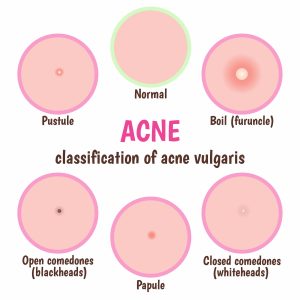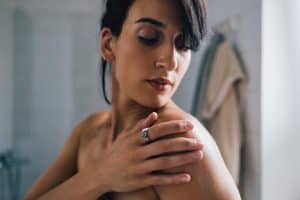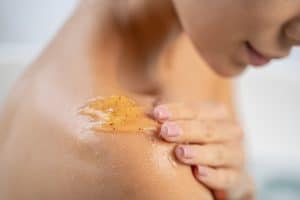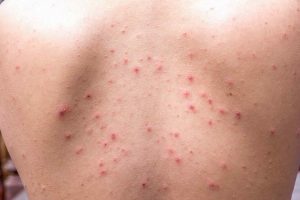It’s likely that you’ve heard the term, “bacne” (a.k.a acne that appears on the back), but you may not be aware of its causes and the best methods of treatment. Read on to learn more about what causes back acne so you can become a pro at managing this unpleasant, yet very common condition.
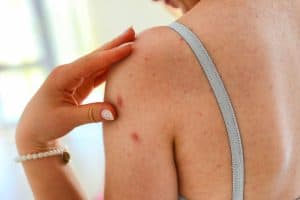
What is “bacne”?
“Bacne” is the result of an accumulation of dead skin cells and oil that clog the pores on the back. This build up may lead to inflammation, which then appears as acne.
What causes bacne in females?
While bacne doesn’t necessarily have a specific cause, it is often related to both genetic and lifestyle factors. More specifically, if acne runs in your family, you may be more likely to experience it yourself. Additionally, having an active lifestyle may lead to acne (specifically bacne) due to sweat and oil that gets trapped under tight clothing.
What are the different types of back acne?
Back acne appears as pimples along your shoulders, upper back, or all over your back down to your waist. “Bacne” can be a one-off pimple or develop in clusters.
Back acne pimples fall into two different groups: inflammatory and non-inflammatory.
Inflammatory acne
Papules
Papules tend to be bigger, more painful pimples caused by irritation to the pore where the walls of the pore break down under the skin’s surface.
These pimples are raised bumps or lesions with no head and feel rough to the touch.
Pustules
Pustules, while they look like whiteheads, are filled with pus (a white or yellow liquid) and surrounded by a red ring. Like papules, pustules are caused by clogged and inflamed hair follicles.
These pimples are more painful and harder to treat, often requiring prescription medication.
Nodules
Nodules are firm, painful bumps under your skin and red bumps on the surface. They happen when your skin’s pores become clogged, trapping dead skin cells, hair follicles, and sebum.
Nodular acne requires medical treatment from a doctor. If left untreated, this kind of acne can lead to severe scarring.
Cysts
Cysts are thin walled cavities that form deep in the skin and are filled with pus. These areoften large and painful.
Cystic acne is caused by bacteria getting trapped in the pore with all the key players (excess oil and dead skin cells), resulting in swelling and inflammation.
Like nodules, cystic acne cannot be treated at home. A doctor or dermatologist may prescribe medication to reduce the risk of scarring and infection.
Non-inflammatory acne
Whiteheads
Whiteheads are a type of pimple known as closed comedones. Comedones are closest to the skin’s surface, meaning they’re the easiest to treat.
Whiteheads are bumps that remain closed by oil and dead skin and are, again, caused by clogged pores. They look like small pimples, but the surrounding area will not be inflamed and red.
Blackheads
Blackheads, also comedones, are open bumps on the skin that fill with excess oil (called sebum), hair follicles, and dead skin cells.
The dark color results from exposure to the air (oxidation) and the way the light reflects off the pore, making it appear black.
Back acne causes
Now that you know what it looks like — here is what causes back acne. Back acne is caused by your skin’s sebaceous glands producing too much oil (sebum). Breakouts happen when your pores and hair follicles become plugged with excess oil, dead skin cells, and bacteria.
While back acne causes aren’t specific or easy to pinpoint, bacne is often related to genetic and lifestyle factors. If acne runs in your family, you may be more likely to experience it yourself.
Hormones
Hormonal fluctuations during puberty, menstruation, pregnancy, menopause, or discontinuing birth control are among the most common back acne causes in women and menstruating people. These hormonal changes can cause your skin’s sebaceous glands to produce more oil, leading to breakouts.
Birth control pills can help treat female back acne by decreasing circulating free Testosterone.
If you think that the birth control pill might be a good treatment option for you and your acne, reach out to your doctor or the expert doctors at Pandia Health about your options.
Genetics
Often your genetics can cause you to be more prone to bacne. Whether you get it from your mom, dad, or even second-degree relatives, studies show that some people might struggle with it more than others throughout their lifetimes.
Stress
Stress is another common cause of female back acne.
When you’re stressed, your adrenal glands release cortisol, prompting your skin to produce more oil that can clog your pores. This leads to an accumulation of dead skin cells and bacterial growth, which can cause acne.
Diet
When people think of what causes back acne (and acne generally), many people think of poor diet and oily foods. But that’s not the full story.
A few studies found that high glycemic index foods (like white bread, potatoes, sugary foods, or white rice) can exacerbate acne. It’s also important to note that they found a link to cows milk (despite it being a low glycemic beverage) also causing acne breakouts.
So when adjusting your diet to reduce acne, you should consider limiting sugar and dairy and increasing your consumption of fresh vegetables, omega-3 rich foods, leafy greens, fish, poultry, and other low-glycemic foods.
Additionally, if you notice that some foods trigger breakouts, avoid them.
Clothes, athletic gear pressing on your skin
“Bacne” can also be caused when a shirt or athletic gear rubs against your skin during exercise, trapping excess oil and bacteria, and leading to clogged pores and zits.
How to prevent back acne breakouts
On the bright side, there are numerous simple steps that can be taken to reduce the severity of bacne (if not prevent it altogether). If you frequently break out on your back, try implementing the following lifestyle habits:
Low glycemic diet
Diet can go a long way in preventing or helping to prevent many health conditions, and acne is one of them. If you notice that your body reacts to some foods by breaking out, simply limit those foods in your diet.
Shower after your workout
Showering is critical in removing dead skin off your body. Keeping your skin clean is necessary for preventing acne breakouts. But don’t overdo it. No more than twice a day should you wash your acne-prone areas. If you wash too much, your body tries to adapt and makes even more sebum/oil. (Don’t forget to wear clean clothes too!)
Exfoliate
While showering after your workouts or during your daily routine, exfoliate to help remove excess oil and dead skin cells from your body..
Use oil-free sunscreen
Sun exposure dries the skin out, causing your sebaceous glands to go into overdrive to lubricate the skin, which can worsen your acne. Using acne products can increase your sensitivity to the sun.
Consistently using sunscreen can help protect your skin. Look for sunscreens specially formulated for acne-prone skin and that are labeled as non-comedogenic.
Wash your sheets & pillow cases regularly
Clean and change your sheets. If you go too long in between washing your sheets, you’re creating an environment for bacteria to thrive. As you know, bacteria + dead skin cells + excess oil = irritants for your skin that can cause acne.
Salicylic acid
Salicylic acid is a chemical exfoliant that removes dirt, dead skin cells, and excess oil from your skin. Salicylic acid helps reduce the redness and swelling of acne breakouts for those with mild acne while decreasing the number of pimples that form.
Benzoyl Peroxide
Another ingredient to look for is benzoyl peroxide. It works by killing the bacteria that cause acne and can also help people with oily skin by removing excess oil and dead skin cells, preventing future breakouts.
Avoid unnecessary friction on your back
Backpacks and sports gear can cause what is known as “acne mechanica.” Sports equipment and clothing trap heat and sweat on your skin, causing friction and irritation. If you have acne or acne-prone skin, this friction, heat, and irritation can cause new acne breakouts.
Wear loose fitting clothing
Sweat during exercise can be what causes back acne, so wearing clean, loose-fitting, sweat-wicking, or natural fiber clothing during workouts can help your skin breathe and prevent sweat from getting trapped and causing breakouts.
Don’t pick at your back
Picking at pimples can worsen acne by spreading harmful bacteria. It can also interrupt the healing process and create acne scars.
Birth Control
Birth control pills can be used to treat female back acne. There’s evidence that all combined birth control pills help treat acne.
Best treatment for back acne
Sign up for Pandia Health and our expert doctors will find the best treatment for you.
Want to tackle what causes back acne AND prevent pregnancy? Talk to the expert doctors at Pandia Health about your options.


Best treatment for back acne
Sign up for Pandia Health and our expert doctors will find the best treatment for you.
Want to tackle what causes back acne AND prevent pregnancy? Talk to the expert doctors at Pandia Health about your options.
Over the counter treatments for back acne
Benzoyl peroxide and salicylic acid work ok for mild back acne. These are typically available over- the-counter in the form of body wash, cream, or gel. Benzoyl peroxide is often used WITH oral antibiotics to prevent antibiotic resistance by the bacteria.
When to see a doctor for back acne
It’s important to note that these methods may not be effective for all individuals with bacne. Furthermore, it’s best practice to consult a doctor prior to starting treatment and if symptoms persist after treatment.
If you’ve been using topical over-the-counter acne medication and products with salicylic acid or benzoyl peroxide for over four weeks and haven’t seen any improvement, reach out to your doctor. Using these products when they do not help your acne can result in hyperpigmentation, excessive dryness, and scars.
Prescription treatments for back acne
For individuals who require stronger acne treatment, specific products may be prescribed by a doctor. More specifically, retinoids are highly effective at combating back acne. In severe cases, a doctor may prescribe oral antibiotics, which work by stopping the growth of bacteria. Usually doctors limit oral antibiotics to 3 months maximum and tell you to use benzoyl peroxide wash/soap at the SAME time as the oral antibiotics to prevent antibiotic resistance by the bacteria that cause acne.
What’s the takeaway?
Back acne is a specific type of acne that appears on the back typically as a result of oil and dead skin that builds up in the pores. While there are several at-home ways that you can reduce the severity of bacne (if not prevent it altogether), it’s best practice to consult a doctor prior to starting a new treatment plan.
How can Pandia Health help?
If you are concerned about your bacne and are looking for professional doctor advice, look no further! Pandia Health now offers online acne treatment service, where a doctor will be able to prescribe you the best treatment for your back acne after you fill out a health questionnaire and provide some photos. The consultation is only $35 and you can use the service from the comfort of your home or wherever you have internet connection and a cell phone (to take photos).
Once your prescription is approved we will FREE ship your acne medication to your mailbox so you don’t have to waste time going to the pharmacy. Sit back and relax, we will take care of your refills too! Sign up today to start your bacne treatment ASAP!
Disclaimer: The above information is for general informational purposes only and is NOT a substitute for professional medical advice. Always seek the advice of your doctor/primary care provider before starting or changing treatment.


